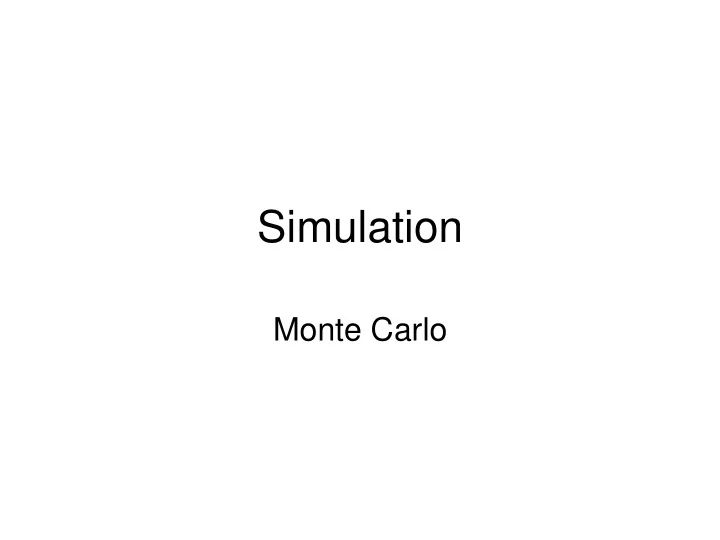

Simulation Monte Carlo
Monte Carlo simulation • Outcome of a single stochastic simulation run is always random – A single instance of a random variable – Goal of a simulation experiment is to get knowledge about the distribution of the random variable (mean, variance) – ” Right ” value is deterministic but it can not be determined explicitly.
Buffons needle • Classical example of simulation experiment where ” exact ” result is known. • Count of Buffon presented a method to define the value for p in 1733. • Throw a needle of length l on a plane that has parallel lines with distance d. • Count how often the needle crosses a line. • Compute experimental probability for hits P = #hits/#trials
Buffons needle – Needle hits a line if • The distance from the center of the a l needle to closest line is less than l sin a , where a is the angle between the needle d and the line • Angle ~ Unif(0, p /2) • Center ~ Unif (0,d/2)
Buffons needle – Probability of hit can be computed using the d/2 volume of the area l/2 bounded by the sinusoidal curve. • p= 2l/( p d) p /2 • Hence estimate is p = 2l/(pd) for experimental value for p.
Buffons needle – Result of a single throw is random • So is the average of N throws. • What do we know after N throws? – Can we define the distribution of the average P after N throws. • Or at least expectation and variance • P is an average of N independent random variables • Single attempts obey binomial distribution with mean p (=2l/( p d)) • E( P )=p.
Buffons needle – Variance of the result in one throw is p(1-p) (result is a Bin(p) variable) • Variance of the average of N independent trials is p(1-p)/N • I.e. Var( P ) = p(1-p)/N – So now we have observation of a random variable with known variance. – We can estimate the relationship between the sample average and the expectation.
Confidence interval – Assume we know a sample average of a random variable – Where is the true expectation with, say 99% probability. • Define sc. confidence interval for which P( P - d < p< P +d) >0.99. • Can be defined if distribution of P is known. • P is average of N independent Bin variables. For large N, P is approximately normally distributed. • d is of form c(p)N^(-1/2).
Monte Carlo -integration – Buffon’s needle was sampling a variable • expectation has a formula as definite integral. – The approach can be used generally to approximate integrals. – Integrate f on [a,b] given that 0<f<c • If x is Unif(a,b) and y is Unif(0,c), determine experimentally the probability p for y< f(x). • The sought integral is p(b-a)c.
Monte Carlo -integration – More experiments lead to more accurate estimate for p. – Confidence interval (error) is proportional to N^(-1/2). • Not efficient for one dimensional integrals • Length of confidence interval and asymptotic behavior depend only on p, not the dimension of the integral. • Efficient way to get rough estimates for high dimensional integrals.
Monte Carlo – Previous Monte Carlo does not apply directly to all cases • Unbounded interval or function – Possible to give up ”y” variable • Compute only E(f(x)) • Cheaper but error analysis is more demanding – Flat upper bound c can be replaced • Find a pdf g such that f(x)< cg(x) • Draw x:s from distribution g • Aim for success rate p ~ 1
Monte Carlo applications – Typical Monte Carlo case is (very) high dimensional integral arising from modelling ray propagation in material. – Each collision is modelled with multidimensional integral (probabilities for absorption, scattering as functions of incident angle, energy, particle shapes, surface properties, adsorption in free path, etc) – For single ray the complexity grows only linearily with number of collisions.
M C Example • Consider scattering of laser beam from a material layer • MSc thesis of Jukka Räbinä 2005 • Goal is to simulate different statistics of the scattered image using Monte-Carlo
Experimental set up
Scattering • Simulate propagation of ray in cloud of particles • Basically ray tracing • Positions and scattering directions of particles are random
Goal of simulation • Compute the intensity, center of mass etc of the scatter image captured by camera • I.e. an integral of a function involving the intensity distribution.
Simulation experiment • Send parallel rays with normally distributed intensity • Collect the (few) rays scattered to the camera
Simulation results • Three different implementations of M-C • Each with 100M simulated rays • Differences in execution times and confidence intervals • Differences can be explained after learning about variance reduction methods
Recommend
More recommend